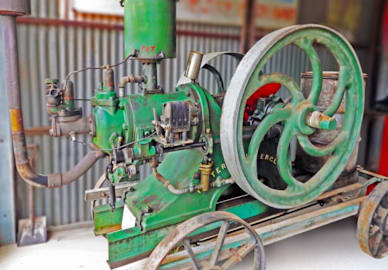When I first started collecting engines I never thought I would own a side shaft engine.
Like most of us just starting out, paying thousands of dollars for an engine just didn’t come into the budget. But after years of collecting and restoring I am now very fortunate to own three different styles of Star engines.
Here is my story of how I acquired these three engines with a bit of luck along with being in the right place at the right time.
I have always had an interest in Australian made engines since I started collecting and the Star engine was at the top of my wanted to buy list. After seeing a Star engine advertised at a clearing sale at Pleasant Hills, NSW I decided it was time for me to try my luck and buy one to add to my collection. With that said, my father-in-law Geoff’s little truck was packed and off we went to the sale.
It was a long drive from where we live, so we had a very early start and arrived there mid morning hoping the engine hadn’t been one of the first items sold. After registration we went straight to the engine and had a good look at the very original farm-fresh Star and hoped the other 35,000 people there (well, to me the crowd looked bigger than game day at the MCG!) had no interest in the Star and were just there for a chin wag and to buy the rest of the large amount of antiques on offer. It was a typical clearing sale where the item you are interested in was about the second last item sold.
I was disappointed that the starting price was more money than I took along, and quite a lot of interest was being shown in the Star. However, I was determined that this trip was not going to be a complete waste of time.
During the day, through conversations with other engine enthusiasts, we came to know of a gentleman named Len who was also at the sale, and not only had he restored an 8hp Star but may also have an unrestored one for sale. After meeting Len and learning quite a bit more regarding Star engines, he invited us to his place to look at his collection.
Len, had a fantastic tractor and engine collection and he was keen to start up a few for us to look at. The first to start was his 8hp Star which he had previously restored and it ran faultlessly. I was in; hook, line and sinker. I had to have one of these engines in my collection! After the working display of some of his engines and tractors we went behind the shed to find a few Star engines covered in corrugated iron.
Star No.937
The first one was a girder Star 6½hp No.937. The other was another Star engine I had never seen before, with a full cast crankcase and the fuel tank sitting horizontal on top of the cylinder, No.110 being 6hp. At this stage, Len was going to restore this engine but would be prepared to sell the girder one. A deal was done and we returned a few weeks later to pick it up. The engine was stuck and missing the magneto, water pump, and carburettor, but I was very happy with it. Over the next few years parts were sourced, a new fuel tank pedestal was cast by Barry McDonald, and the fuel, kero and water tanks were made by Bill Singleton of Ballarat who did a fantastic job at a great price.
After talking to Bill, he informed me that years ago he made the patterns and a core box for an early Star carburettor but never had one cast. Bill was prepared to get two complete castings done. They came up a treat! Being a fitter machinist by trade, I had an interesting time machining them very carefully. Although this engine runs, it still needs a water pump and plumbing to finish it off.
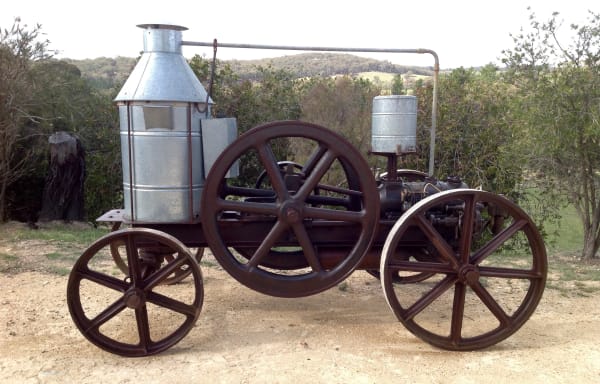
Star No.110
Some time later, after a phone call to Len, he was prepared to sell me No.110. A price was agreed on and plans were made to collect the engine. Len told us that the engine had been used to pump water from a dam and was left running unattended when one of the governor weights came off. The governor was not recovered from the dam, causing the engine on its immediate run after loosing the governor to race and break the connecting rod. That would be the last time the engine was used.
Once home it was time to take a closer look. The engine was also missing the magneto and carburettor, but otherwise complete besides a few battle scars. A plan was made to make new timbers using the same original dimensions as the old ones that were rotted out. Interestingly it is sitting on a Jelbart transporter and I have seen another one using Jelbart wheels. I recently took this engine to our local rally at the Australian National Field Days where it ran faultlessly for three days. A big thank you goes to the club members who ran it while I was at work.
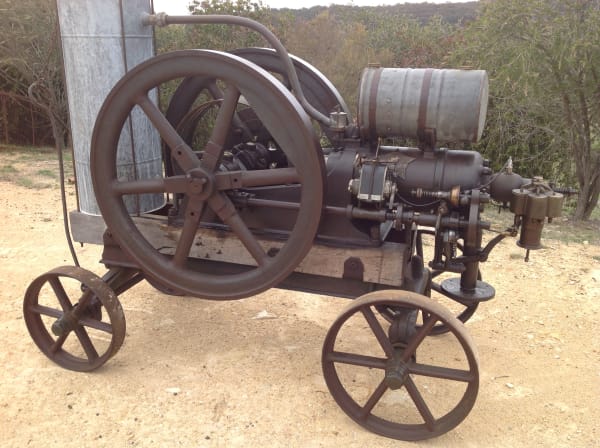
Star No.57
The last of the engines is No.57, a hopper-cooled 6hp Star. A mate of mine, Tim, found a clearing sale near Wodonga that had a few hopper cooled Stars for sale, so we decided to go. We arrived the day before and found where the sale was at, and although we were a bit late for the viewing we still went in and had a look. While looking over the Stars I met Steve who was also there for the viewing, and he asked me if I was interested in the Stars. “You bet” I said, “I’d love to own one of these hopper-cooled ones.” Steve went on to say he had one in his shed he collected off a property with a Famous engine. “Would you be interested in selling it?” “Maybe, I have been thinking about it.” “How much would you want for it?” “Well that depends on what these ones bring tomorrow.” We discussed Steve’s engine and what it was missing. Steve told me he would bring some photos of it tomorrow, the day of the sale.
The next day we find Steve and, true to his word, he shows us the photos and says to keep them. It was a very nice original engine but again missing the carburettor and magneto. We waited for the Stars to be auctioned at the sale, and I did buy a good parts engine. After the sale had finished, Steve gives me a price on his engine. I agreed on the price so we went to Steve’s place, looked at his collection of engines and a brilliantly built home made tractor he was doing. Then we loaded up the engine and headed for home. This engine shows very little use and is in great condition. After rebuilding the timber transporter and freeing every thing up it was running a few weeks later. Thanks, Steve!

Never give up!
So, don’t be disappointed if you miss out on something at a clearing sale, but take the opportunity to talk to and meet new people. You may end up getting leads on engines as I have done with these three Stars. If you have any history or information on Chas Walker or Deutscher built engines I would be happy to talk to you. *Justin Wentworth.
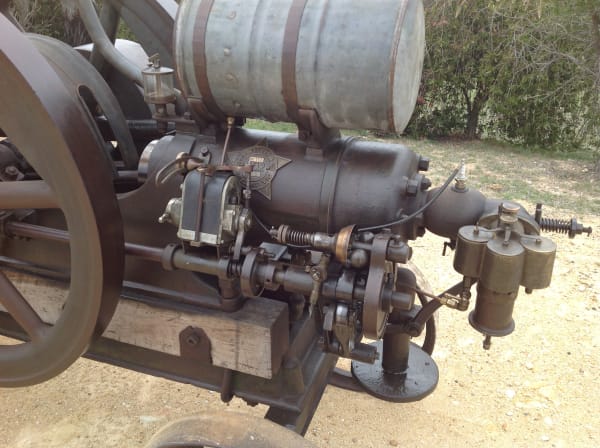
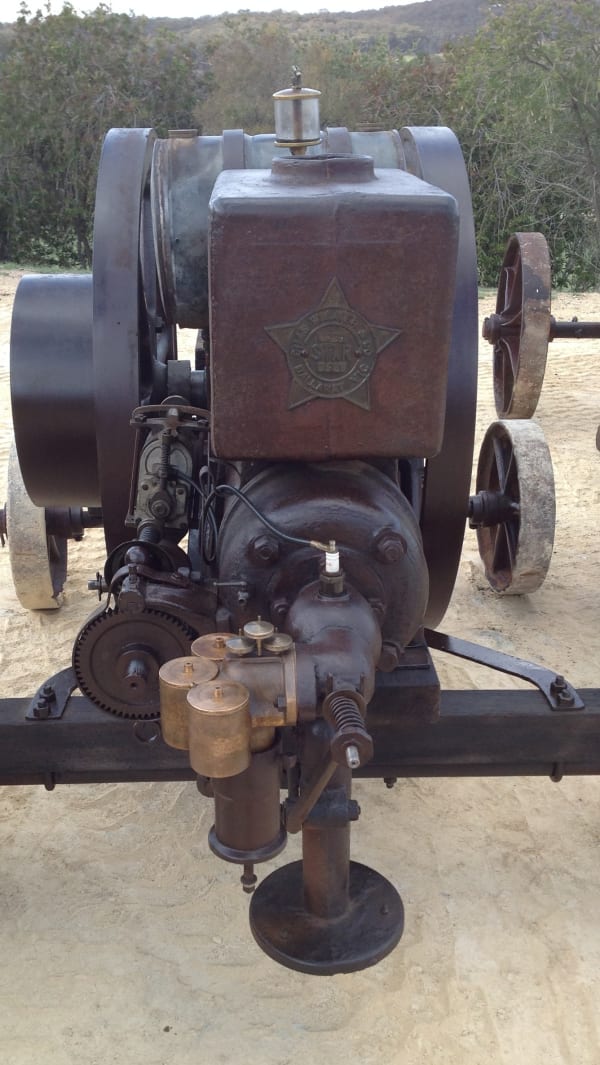
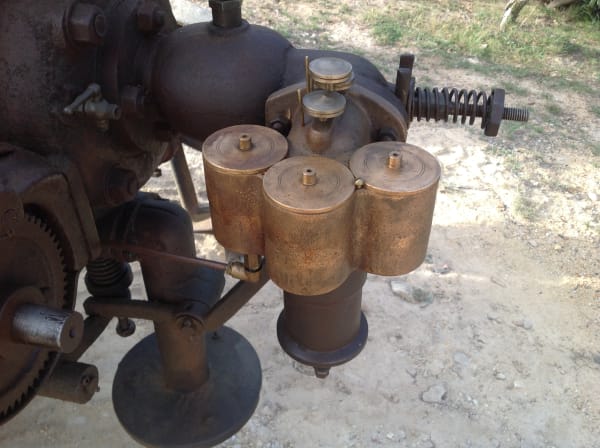
New Ballarat Industry –
Star Oil Engine
It is just a year since Mr Charles E Walker arrived in Ballarat from Hamilton, where he had been manufacturing oil engines for nearly 11 years. Mr Walker was not in the Golden City long before he had made arrangements for the building of his oil engine, and the Eureka Foundry, better known throughout Australia as Cowley’s, was selected for their manufacture.
The Star engine has already found great favour throughout Victoria and New South Wales, and a demand for the engine far greater than the output has been created. Very little had been known of Mr Walker’s advent into Ballarat until Wednesday afternoon last, when a full train of 15 truckloads of these oil engines left Messrs Cowleys’ Eureka Foundry and shunted into the Ballarat yards preparatory to their transport for New South Wales. Every engine in this record train load is to fulfil a part order.
The Star engine is different from all others; it is adapted for any class of work, and is made in all sizes. Amongst its many uses may be mentioned those in connection with sheep shearing, chaff cutting, wood sawing, water pumping, milking cows, etc. Its beauty is in its simplicity and small cost of running. It is an engine that never gives any trouble and once used the farmer will have no other for general work. The popularity of the engine is proved by the demand which as already stated, is far greater than the output. The advent of building the Star engine in Ballarat already means employment for over 60 hands, and Mr Walker anticipates a big increase in this number when the complete installation of further machines has been made. It is a new Ballarat industry, which has been built up steadily, quite unknown to the majority of local people. The proprietors have arranged for a large number to be built at the Eureka works, and
Mr Walker says that the big train load of Wednesday is just the forerunner of a continuous output of Star oil engines. The firm invites inquiry from any part of Australia, and a letter to Charles Walker and Co., Engineers, Ballarat, will receive immediate attention.
Ballarat Courier, page 8,
Saturday 2 February 1918.
Source: Trove.
Who was Mr Charles E Walker?
Charles E Walker was a partner of Deutscher Son and Walker who produced Gem engines in Hamilton, Victoria from 1909 to 1917. Having gained full control of the partnership in 1917, Charles moved the operations to Ballarat, and under the name Charles Walker and Co. engine manufacture was carried out by the Cowley’s Eureka Ironworks until the demise of Charles Walker and Co. in the 1930s.
The total number of Star oil engines produced is not known, but is believed to be in the order of 1,500 units.
The McKenzie patent ‘traction wheel’, a tractor wheel, recognised for its remarkable grip under difficult conditions was another of Walker’s products manufactured by Cowley’s.


